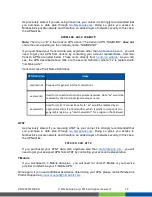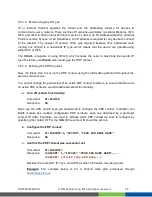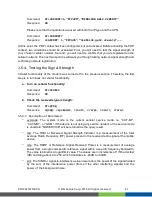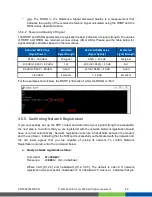
3. Getting Connected
3.1. Background Information
Both LTE-M and NB-IoT are types of cellular network technologies. Specifically, they fall under
the category of a low power wide area network (LPWAN), which is a standard created by 3GPP,
the main body in charge of developing mobile protocol standards. LTE-M and NB-IoT are more
commonly known as LTE Cat M1 and Cat NB1, respectively. The QBG96 modem supports both
standards.
The QBG96 supports the North American carriers listed in the table below. Please note the
network technology currently supported by each carrier.
Carrier
LTE Cat M1
Cat NB1
How to Purchase SIM?
How to Purchase Data Plan?
Verizon
Yes
No
NimbeLink or Verizon
NimbeLink or Verizon
AT&T
Yes
No
NimbeLink or AT&T
NimbeLink or AT&T
T-Mobile
No
Yes
T-Mobile
T-Mobile
3.2. Setting Up the SIM
3.2.1. Purchasing the Correct SIM
As shown in the block diagram below, the QBG96 has a micro SIM slot and a soldered-down
Verizon SIM. As a result, you can either use a physical SIM card, which is inserted into the
micro SIM slot or you can use the Verizon eSIM that comes included with the modem. If you
choose to use the Verizon eSIM,
provides a tutorial on how to select the
solder-down SIM.
If you need to purchase a T-Mobile SIM, you will need to purchase the SIM card directly through
T-Mobile. The
T-Mobile SIM on NimbeLink’s website
will not
work with an NB-IoT device. If you
need to purchase an AT&T or Verizon SIM card, QBG96 compatible SIMs are provided in the
links below, otherwise you may purchase a SIM card directly through the respective carrier.
Verizon
:
https://nimbelink.com/products/nl-sim-ver-m1/
AT&T
:
https://nimbelink.com/products/nl-sim-att-ctri/
Note: The QBG96 modem uses a micro SIM slot, so please purchase either a Tri-Cut or 3FF
sized SIM.
For development, purchasing a SIM card and data plan through NimbeLink is recommended
over purchasing directly from a mobile carrier. If the user has integration or deployment issues,
PN 1002152 REV A
© NimbeLink Corp. 2019. All rights reserved.
7








































